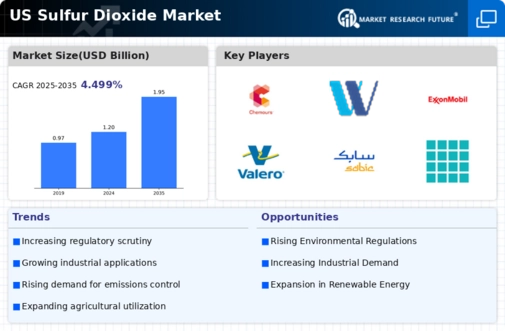The sulfur dioxide market exhibits a competitive landscape characterized by a blend of established players and emerging companies, driven by increasing demand across various sectors such as food preservation, chemical manufacturing, and environmental applications. Key growth drivers include the rising focus on sustainability and regulatory compliance, which compel companies to innovate and enhance their operational efficiencies. Major players like Linde plc (IE), Air Products and Chemicals Inc (US), and Praxair Technology Inc (US) are strategically positioned to leverage their technological capabilities and extensive distribution networks, thereby shaping the competitive environment through a combination of innovation and regional expansion.
In terms of business tactics, companies are increasingly localizing manufacturing to reduce transportation costs and enhance supply chain resilience. The market structure appears moderately fragmented, with a few dominant players exerting considerable influence while allowing room for smaller entities to thrive. This dynamic fosters a competitive atmosphere where collaboration and strategic partnerships become essential for maintaining market share and driving growth.
In October 2025, Linde plc (IE) announced a significant investment in a new production facility aimed at increasing its sulfur dioxide output to meet the growing demand in the semiconductor industry. This strategic move not only enhances Linde's production capabilities but also positions the company to capitalize on the burgeoning market for electronic components, which is expected to expand substantially in the coming years. The investment underscores Linde's commitment to innovation and its proactive approach to addressing market needs.
In September 2025, Air Products and Chemicals Inc (US) entered into a partnership with a leading agricultural firm to develop sustainable solutions for sulfur dioxide applications in crop protection. This collaboration highlights Air Products' focus on sustainability and its efforts to diversify its product offerings. By aligning with agricultural stakeholders, the company aims to enhance its market presence while contributing to environmentally friendly practices in the agricultural sector.
In August 2025, Praxair Technology Inc (US) launched a new digital platform designed to optimize the supply chain for sulfur dioxide distribution. This initiative reflects the growing trend of digital transformation within the industry, as Praxair seeks to improve operational efficiencies and customer engagement. The platform is expected to streamline logistics and enhance real-time tracking, thereby providing a competitive edge in a market that increasingly values reliability and responsiveness.
As of November 2025, current competitive trends indicate a pronounced shift towards digitalization, sustainability, and the integration of advanced technologies such as AI. Strategic alliances are becoming increasingly pivotal, as companies recognize the value of collaboration in navigating complex market dynamics. Looking ahead, competitive differentiation is likely to evolve from traditional price-based competition to a focus on innovation, technological advancements, and supply chain reliability, positioning companies to better meet the demands of a rapidly changing market.



















Leave a Comment